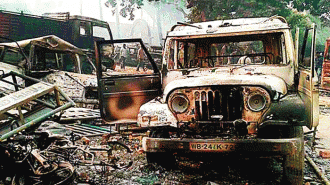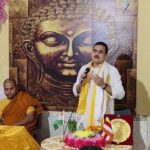MONUMENTAL BETRAYAL OF BENGAL, ITS VALUES
- By : Anirban Ganguly
- Category : Articles

The State faces an existential and identity crisis, with the growth of jihadism and rabid Islamist lumpens aided and supported by the party in power. It poses a severe challenge to the well-being of the State itself
I mourn for Bengal, because Bengal has pushed itself into an apparently inextricable cycle of degenerative politics from which it appears unable to lift itself. The land of actual revolutionary nationalists, of fighters for India’s freedom, of some of the highest and noblest thoughts in the evolution of India’s intellectual traditions, has now turned into a playground of forces that conspire to break India. They are doing all this with the active connivance of the party in power in the State.
While communists worked to weaken Bengal, to dilute and then destroy her civilisational and cultural heritage and memory, her sense of a great past and systematically hammered away at all that stood as distinct and inspiring symbols of ‘Bengaliness’, the Mamata Banerjee-led Trinamool Congress regime is consciously and assiduously working to turn Bengal into a swamp of intolerance, into a frontier land of jihadism in which only the extreme anti-nationals, the extreme anti-India forces, and the most rabid elements shall survive and thrive.
One of the first and toughest existential questions before Bengal was during independence, when a strong possibility arose of Bengal becoming part of Jinnah’s Pakistan utopia. It was only Syama Prasad Mookerjee’s powerful and tactful intervention during the period, that saw a solid unity crystallise against the demand that the entire Bengal be given away to satisfy Jinnah’s appetite for an Islamic state. Syama Prasad Mookerjee had then saved Bengal so that Bengalis could live in dignity and security. Ironically when he demanded that Pakistan be sanctioned for perpetrating atrocities on its Bengali minorities and for pushing them into India as refugees, it was the comrades who took out a procession in the streets of Calcutta, condemning Syama Prasad.
Today, Bengal faces its second existential and identity crisis, with the growth ofjihadism and rabid Islamist lumpens aided and supported by the party in power. This poses a severe challenge to the welL-being-being of the State itself, to its future and to the vision that had saved it from clutches of the Muslim League.
Yet, except for a few commentators, for a few groups operating on the ground, and apart from the BJP, no intellectual or leader has expressed concern over these developments; no public intellectual — especially the jet-setting, foreign-clime beholden type who is ever ready to warn people of the spectre of ‘HinduRashtra’ and of the bogey of fascism — has even as much as alluded to the rising climate of intolerance in Bengal and to how non-state actors are gradually striking deep roots, and of how a section of the Bengali Hindus — especially those belonging to the weaker and marginalised sections of society — are bearing the brunt of this rising jihadism.
Our executive class champions of human rights are strangely silent on the challenges faced by these sections in Bengal, on the near routine harassment and atrocities that they have to bear at the hands of jihadists. The latest cycle of violence and attacks in Dhulagarh, Mollargate, saw the same blanket of silence from the majority among the so-called mainstream Indian media and the so-called mainstream intellectuals. In the latest cycle of violence, the same pattern of terror was followed, shops gutted, women molested, threatened, homes burnt, men beaten. And so democratic is Mamata Banerjee that each time a central team is sent by the BJP — only and always by the BJP because no other party dare send teams because that would offend ‘didi’ and her rabid constituency — her police and lumpens prevent them from proceeding to the affected areas. The same was done during the Kaliachak episode when a team led by BJP Member of Parliament Bhupendra Yadav and SS Ahluwalia tried to visit the spot; and the same was repeated in the case of Dhulagarh, when the parliamentary team constituted by BJP president Amit Shah was stopped from visiting the place.
One recalls how, when Mamata Banerjee was prevent by the communist Government from visiting Singur, she returned to the State Assembly and with her senior leaders in tow, broke furniture in the Assembly lobby, hurled expletives and turned upside down the entire proceedings of the day. In fact, today, Mamata Banerjee heads one of the most intolerant and Constitution non-compliant State Government in India. She has even outdone her communist opponents in this non-compliance of hers.
Reverting to our discussion on the degenerative web of politics that afflicts Bengal, the first round of degenerative politics set in the early parts of 1970s, when the self-destroying vision of Charu Mazumdar’s Naxal utopia took hold of a so-called avant-garde section among the Bengali intelligentsia and inspired them to indulge in extreme violence, wiping out an entire generation and turning Bengal into a cesspool of instability and stagnation.
Interestingly, a section in the State and beyond still continues to hold a fascination with Charu’s utopia and its false dimensions, and continues to work to put it into operation and fruition in today’s India. While their comrades-in-arm openly work to destroy and liquidate India through the barrel of the gun, these others continue to operate in urban India and intellectually push the cause of breaking India into pieces.
The second phase of degenerative politics began with the advent of the liberators of the proletariat, the political charlatans who, while promising a liberated existence full of opportunities, imposed a rule that pushed Bengal even more backward, destroyed her edifices — industrial, educational — again erasing possibilities, eradicating opportunities for an entire generation of Bengalis who had to migrate out of the state in droves for its existence and growth.
Even Amartya Sen’s economic theories or the supposed power of his personality — worshipped by comrades — could not salvage Bengal from the morass it had started sinking in. This period of three decades and more, saw Bengal crumbling and deconstructing herself in all her parts.
The third phase of degenerative politics began when a supposed ‘Poriborton’ turned into a mandate for further altering the character of the State, for unlimited oppression, for a shrinking of the democratic space and for the promotion of lawlessness and jihadism. Like the first existential challenge that Bengal faced, the present one is equally if not more acute, more daunting and more lethal for it is abetted by those who are supposedly the democratic trustees of the State.
I mourn for Bengal, because she is losing herself. I mourn for Bengal, because she seems unable to or incapable of extricating herself from grips and a cycle of a chronic degeneration.

















